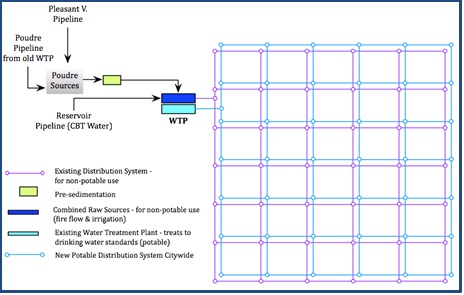Dual Distribution Systems for Separate Supply of Potable Water to Meet Indoor Demand
Approximately 50% of total water demand in the City of Fort Collins is used for landscape irrigation. By matching water quality to the intended use, the city could halve the amount of water they treat to drinking water standards. Using raw or minimally treated water would decrease energy use and greenhouse gas emissions, decrease water production costs, improve drinking water quality and provide more flexibility to meet future regional water demands of a growing population. The CSU Urban Water Center is currently conducting a feasibility study to evaluate implementation of this concept.
Fort Collins Utilities Dual Water Systems Study: Final Report
Wastewater Collection Systems
A Review of Advanced Sewer System Designs and Technologies
Risk of Water Main Failures
The inventory of U.S. water transmission and distribution pipelines is over two million miles, and utilities face rising concerns about its condition and growing backlog of replacement needs. Water rates would have to rise substantially to slow the growth of the backlog, much less to whittle it down. Several projects have been completed to develop management tools for operations management and capital planning. The tools range from the budget process itself to tools with narrower uses, such as a model to evaluate consequences of main breaks. By using these tools selectively and effectively, utilities can upgrade performance, extend pipe lifetimes, and clarify business cases to inspire confidence in customers and governance authorities.
Performance of Dual Distribution Systems
This project was a retrospective assessment of dual water systems, which were identified by USEPA’s Sustainable Water Infrastructure Initiative as a technology to improve water safety and reduce cost of drinking water infrastructure. The case studies showed that the main uses of water reuse systems are for non-potable applications such as landscape and agricultural irrigation, toilet flushing, industrial process water, power plant cooling, wetland nourishment and groundwater recharge. Although there have been isolated incidents of cross-connections, there have been no major public health problems from the use of reclaimed water in the U.S. As dual water systems extend water supplies and help with water conservation, they become part of total portfolios of water supply options, particularly for outdoor and industrial uses, including cooling.

